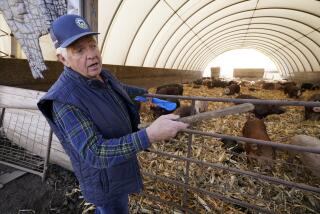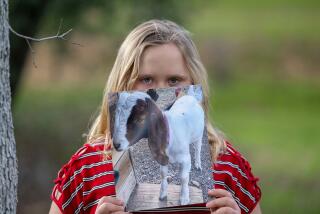Budget Cut Keeps These Little Pigs Out of Big Markets
- Share via
The pig moved through the chute to the butcher’s room. The stunner stunned him and left him dead. He was put on hooks to hang from his feet. The blood dripped out, into a bucket. Pig’s blood, in the view of the USDA, is inedible. But clients--especially the Indochinese--like it, the farmer said, and use it for sauces. The carcass was thrown in a tank of scalding hot water. The soapy film stripped most of the hair; a machine with razor-like edges removed the rest by flopping the carcass as if it were popcorn. The pig was put back on hooks and hung by its feet. A blow torch removed the last stubbles of stray hair. A chain saw cut open the body, splitting it in half. The entrails were removed and sprayed with a hose. The pig was ready for sale.
The hog hung by its feet, twisting slowly in the wind. Blood, mixed with water, flowed like a river on the concrete below. No doubt about it--this little piggy had gone to market.
It had been “stunned” by a stunner approved by the U.S. Department of Agriculture. It wouldn’t be too long before this 125-pound Porky would fry on somebody’s griddle.
As they say at the movies, “That’s all, folks.”
Pick Your Own Pig
It was another busy Saturday at Magoffin Stock Farm in rocky Dulzura, 35 miles southeast of San Diego on California 94. Magoffin’s is the only place in the county where you can walk in, pick out the pig you like and have it gutted right in front of you.
It’s not the sort of place moral vegetarians would enjoy.
“The pig is more like a human than any other animal,” said Magoffin, 51, a large, friendly man with a college degree and a love of all things rural. “At the time he died, John Wayne had parts of a pig’s heart in his heart. Pig skin is used on burn victims, because the human body won’t reject it. We sell a lot of pigs to the research divisions of the VA hospitals, as well as UC San Diego medical school.”
Magoffin slaughtered several on Saturday. With the help of his brothers--Dick, 49, and Gary, 60--he slaughters 15 to 30 a week and as many as 1,000 in a year. The Magoffins started breeding hogs in 1973 and graduated to butchering eight years ago. Since 1980, they’ve slaughtered 10,000 pigs, and in that time, the business has changed almost 10,000 ways.
The Agony of Being Small
The casual observer might think business is great. Not really. Magoffin had to go to “the you-pick-’em orchard approach” just to make ends meet. At the risk of a pure-pork pun, he and his brothers feel hog-tied by government regulations. Uncle Sam is making it mighty hard, they say, to keep bringing home the bacon.
Their dream is to sell directly to cafes, delicatessens and supermarkets, but they can’t, they say, because the government won’t let them. They aren’t a big-enough operation to warrant USDA inspection. Magoffin says you have to be a Farmer John, slaughtering 4,000 pigs a week, to qualify for that. So, you have to be inspected by the state.
Ah, there’s the rub.
In the cost-cutting frenzy of the 1970s, Sacramento surrendered inspection to “the feds,” as Magoffin calls them, putting “the little guy” in the trap of a Catch-22: Too small to be inspected by the feds, who do the inspecting for the state. As a result, Magoffin is now out of the breeding business entirely. On a farm that once had 3,600 pigs, he now has 80. He buys most of his pigs from other breeders.
His only hope, Magoffin said, was to sell to individuals who come to the farm Fridays and Saturdays, paying bargain prices for take-home hog. The method is allowed, provided an area supervisor--hired on a contract basis by the state--makes periodic inspections of the premises.
Pending legislation--dubbed “equal to,” as in equal to the USDA--would restore state licensing and inspection, allowing little guys to compete again on the open market. With “equal to,” Magoffin calls the potential of the farm unlimited, as in, “We’d have our own version of the golden arches.”
Until then, most of his clientele is Indochinese refugees and upscale party hosts. Hogs slaughtered at Magoffin’s farm have ended up roasting at tailgate parties before Chargers games, at bashes feting Dennis Conner and the America’s Cup and at functions honoring the Elks Club and Veterans of Foreign Wars. The elite fighter pilots known as “Top Gun” have hauled many a pig from Magoffin’s farm to Miramar Naval Air Station--although not by F-14.
One of his clients is Jun Dag Dag, 35, a civilian employee working for the Navy at North Island. Dag Dag was there on Saturday, having driven to Dulzura from his home in Mira Mesa. He bought a pig for $120, which he called a steal for two months’ worth of ham, bacon and sausage.
“I’ll barbecue some of it tonight,” he said, cutting up the intestines. “To buy a pig this size from a butcher would cost about $1.75 a pound--almost double what I pay here. I love pig, which I learned to cook as a boy in the Philippines.”
Magoffin said “boat people”--refugees from Indochina--saved his business. Two who tried to kill it, in his view, were Jerry Brown and Jimmy Carter.
The Magoffins blame former governor Brown for firing more than 300 state inspectors, thus giving power to “the feds.” They blame Carter for double-digit inflation and soaring interest rates that they say crippled chances of building the business through loans that farmers could afford.
“My loan actually doubled,” Magoffin said. “I couldn’t handle it.”
“Carter killed us,” said younger brother Dick. “He ruined the farmer in America. He’s the reason for the interest rates, the bankruptcies, the foreclosures. Now we can’t catch up.”
Even so, they try. If it comes to pass, they hope a George Bush administration will spur a mild recovery that they say started under Reagan. (They clearly won’t be voting Democratic.) They hope Sacramento pushes through “equal to” legislation. But more than anything, they hope the government--regardless of who’s heading it--leaves them alone.
More to Read
Sign up for Essential California
The most important California stories and recommendations in your inbox every morning.
You may occasionally receive promotional content from the Los Angeles Times.










